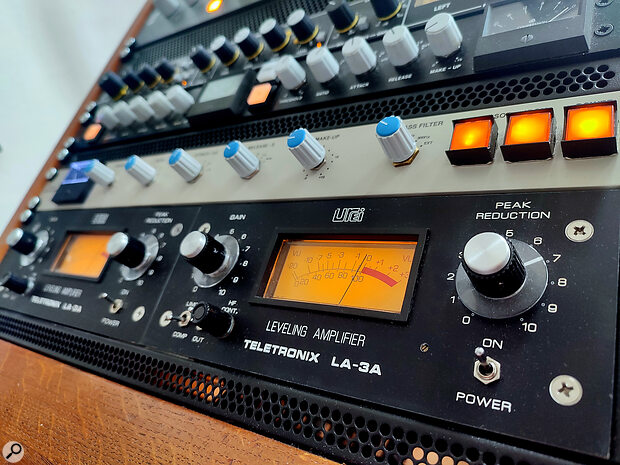 Many classic compressors have a sound that is either right or wrong. If your chosen settings don’t work, use something else!
Many classic compressors have a sound that is either right or wrong. If your chosen settings don’t work, use something else!
Not everyone wants their compressors to sound the same. But once you’ve set yours up how you like them, why change anything?
A couple of years ago, I wrote an article explaining why I never touch any settings on my calibrated outboard gear. You can read that article at www.soundonsound.com/techniques/calibrating-your-mixing-setup; in a nutshell, it facilitates reliable, easy recall. Lately I had many people ask how this could possibly be a good thing, since every record is different. Here’s why.
People generally understand why I calibrate the gear in terms of input levels. But their next question is usually something like “But you adjust attack and release times as needed, right?” Well, no, I don’t. That’s the point for me. And I know a lot of engineers who work the same way. For example, Chris Lord‑Alge is famous for buying another 1176 to set it differently, rather than changing settings on one of the units he has. Not everyone has the space and money to do that, but that’s the spirit. It’s equally true for plug‑ins, too. The reason why this approach does work is simple: every unit, and specifically every compressor, has a sweet spot where it sounds best. And that sweet spot depends on the application and the user.
I have done this long enough to know that 12:1 is my preferred ratio on an 1176 for vocals, and that I like it to slam on loud consonants. If that sound doesn’t work, another ratio or attack likely won’t change the way I feel.
Locked Down
Let’s take a lead vocal. There’s many ways to compress it, but it’s safe to say an 1176 is a favourite choice for many. If you’re one of those people, are you constantly varying the ratio and attack and release time to see what sounds best on a given voice? I know I don’t. Attack 3 and release 7 for me just works on vocals, as does the 12:1 ratio. Many prefer 4:1; I know people using 20:1 and I’m sure there’s people loving 8:1, too. My point is: to me, there is no point fiddling around on every mix. I have done this long enough to know that 12:1 is my preferred ratio on an 1176 for vocals, and that I like it to slam on loud consonants. If that sound doesn’t work, another ratio or attack likely won’t change the way I feel. I’ll use a different compressor with a different sound.
Or consider the legendary SSL bus compressor (and its many, many clones). Ask any engineer how they would use this on their stereo bus and you’ll get two possible answers. One is “I never use it because I don’t like it.” Two is “I use it on every mix — with these settings.” That may be a slight oversimplification, but you know what I mean. Either you’re an advocate of classic VCA compression on a mix or...
You are reading one of the locked Subscribers-only articles from our latest 5 issues.
You've read 30% of this article for FREE, so to continue reading...
- ✅ Log in - if you have a Digital Subscription you bought from SoundOnSound.com
- ⬇️ Buy & Download this Single Article in PDF format £0.83 GBP$1.49 USD
For less than the price of a coffee, buy now and immediately download to your computer, tablet or mobile. - ⬇️ ⬇️ ⬇️ Buy & Download the FULL ISSUE PDF
Our 'full SOS magazine' for smartphone/tablet/computer. More info... - 📲 Buy a DIGITAL subscription (or 📖 📲 Print + Digital sub)
Instantly unlock ALL Premium web articles! We often release online-only content.
Visit our ShopStore.
